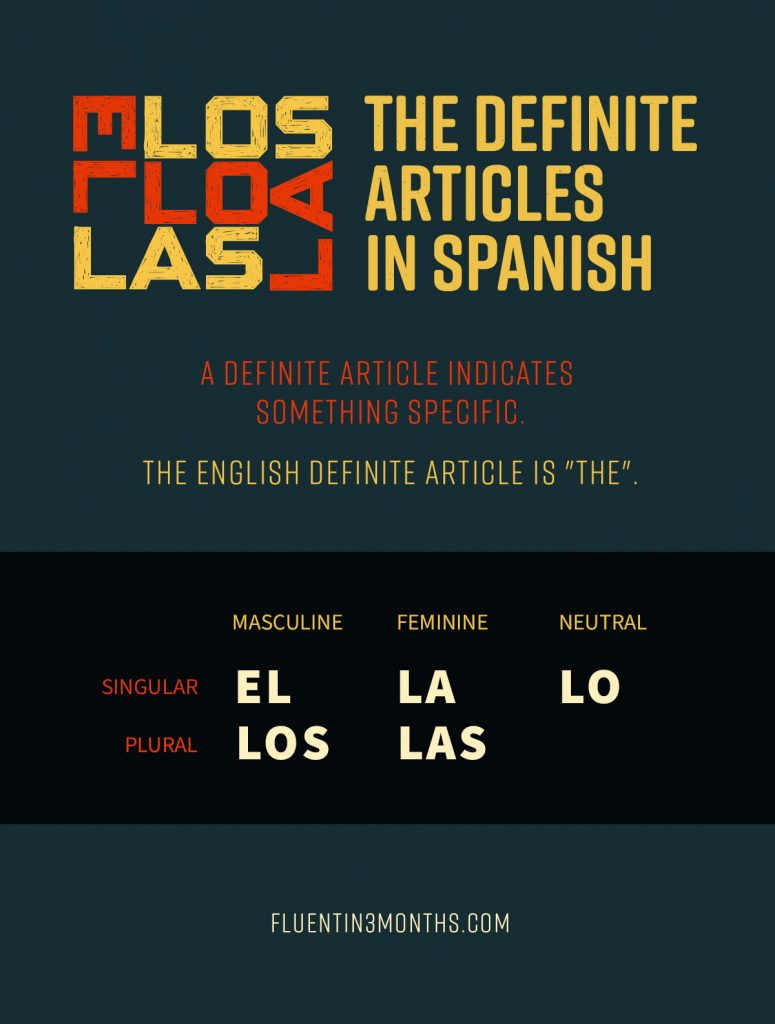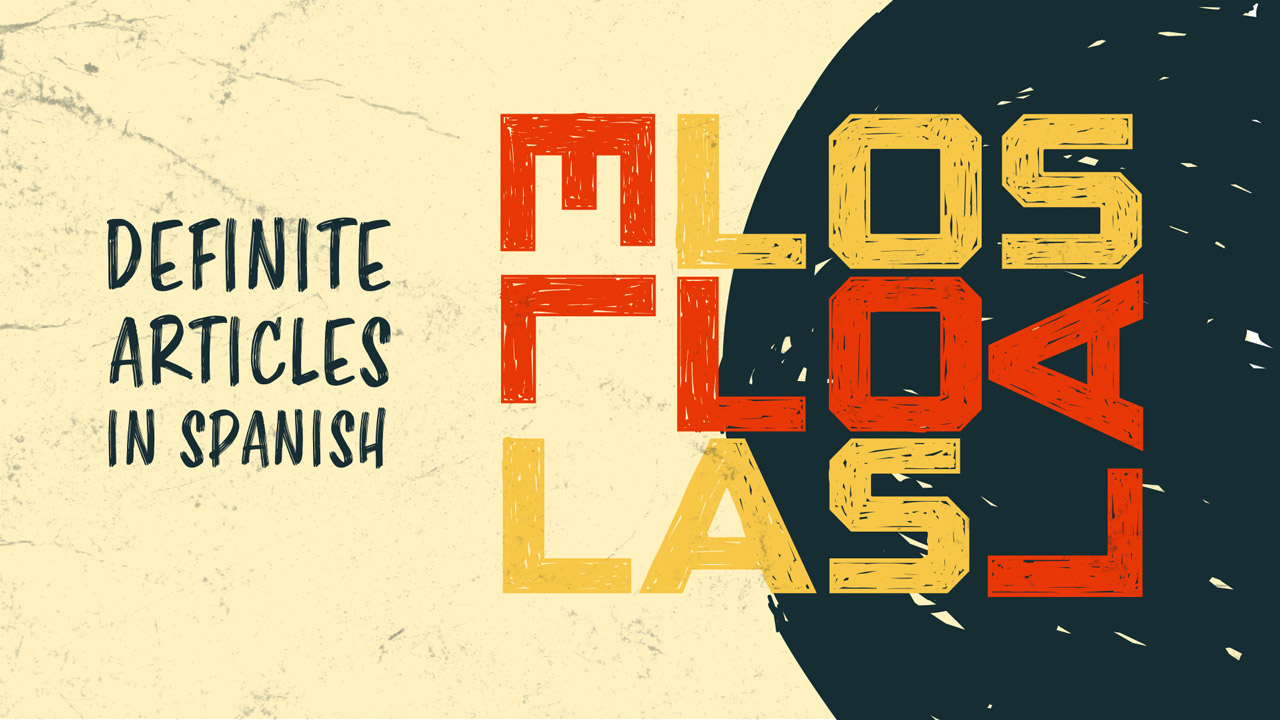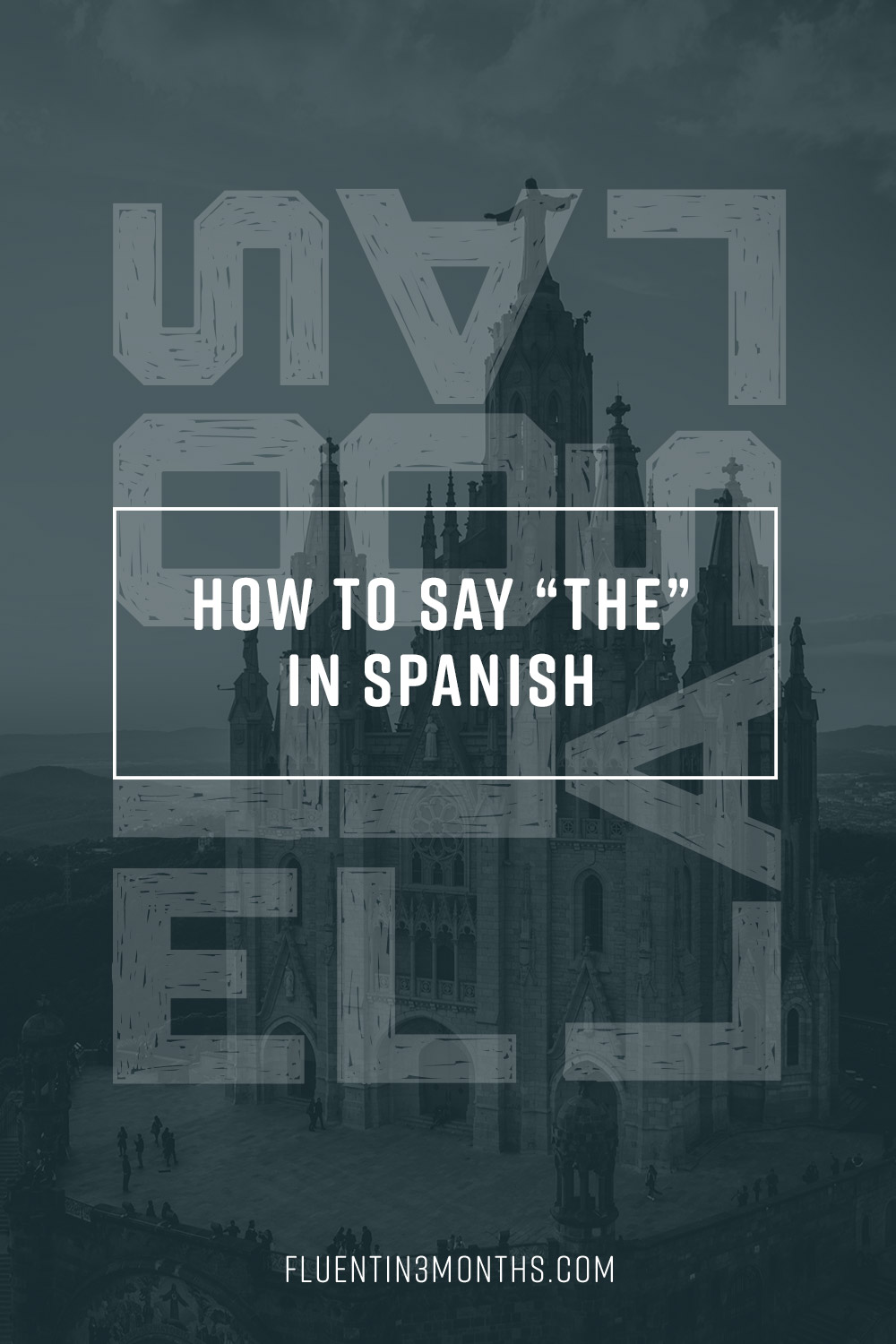Everything You Need to Know About Definite Articles in Spanish
In English, we only have one definite article: “the”. But there are five definite articles in Spanish: el, la, los, las, and lo.
I’ve got good news for you: it’s really not complicated, and I’ll show you everything you need to master definite articles in Spanish. I’ve included a lot of examples to make learning easier.
Here’s what we'll cover:
Table of contents
- What Is a Definite Article in Spanish?
- How Many Definite Articles Are There in Spanish?
- Gender for Definite Articles in Spanish
- How Do You Use Definite Articles in Spanish? An Explanation With Examples
- Rule 1: Use Spanish Definite Articles to Talk about Something General
- Rule 2: Use Spanish Definite Articles to Refer to Something That Is Unique, Has Already Been Mentioned or Is Already Defined for the Reader/Listener
- Rule 3: Use Spanish Definite Articles to Mention a Person’s Title, Unless You’re Addressing Them Directly.
- Rule 4: Use Spanish Definite Articles in Front of Possessive Pronouns
- Rule 5: Other Ways to Use Spanish Definite Articles
- Rule for the Contraction of the Masculine Singular Definite Article in Spanish
- When to Use the Definite Article El With Feminine Nouns in Spanish
- What Are Definite and Indefinite Articles in Spanish? Rule and Examples
- That’s Spanish Definite Articles in a Nutshell For You!
¿Listos? ¡Vamos! (“Ready? Let’s go!”)
What Is a Definite Article in Spanish?
What does artículo definido (“definite article”) mean in Spanish? Let’s break the term down.
In grammar, an article is a small word that goes in front of a noun. The article gives some indication about the identity of the noun. In English, the main articles we use are “a”, “an” and “the”.
A definite article is used to describe something specific. This can be something that has already been mentioned in the text or conversation, something unique, or something that is being identified. In English, there is only one definite article: “the”.
The Spanish definite articles are:
| Masculine | Feminine | Neutral | |
|---|---|---|---|
| Singular | el | la | lo |
| Plural | los | las | — |
Note: Don’t confuse the article el with the subject pronoun él (“he”). The article doesn’t wear a tilde (“accent”). Here is a refresher on Spanish pronouns in case you need it.
When I was learning Spanish, I used a trick to remember the purpose of definite articles. I like to think that definite articles are the word form of a pointing finger:
- el amigo – “the friend” la casa – “the house”
- los estudiantes – “the students”
- las hermanas – “the sisters”
Definite articles show that you’re talking about the thing, not only a thing.
Here’s a downloadable infographic you can keep to remember the Spanish definite articles:

How Many Definite Articles Are There in Spanish?
As you’ve seen in the chart above, there are five definite articles in Spanish:
- the masculine singular el
- the feminine singular la
- the masculine plural los
- the feminine plural las
- and the neutral lo
There are two interesting facts to notice at this point.
First, lo is often left out when you learn Spanish as a foreign language. That’s why you might have read that there are only four definite articles in Spanish.
And second, definite articles in Spanish (almost) always agree in number and gender with the noun they describe. (I’ll explain what I mean by “almost” later on.)
Gender for Definite Articles in Spanish
You might be wondering why there are so many ways to say “the” in Spanish. Let me explain.
Nouns in Spanish have a gender: they’re either feminine or masculine. Think of words like la casa (“the house”, feminine) and el árbol (“the tree”, masculine).
Mini identification hack: Feminine nouns usually end in -a, -ción, -sión, -zión, -dad, -tad, -ez, and -triz. E.g.: la pasión (“passion”), la bondad (“goodness”), la cicatriz (“scar”).
Now, Spanish is quite fussy about this gender thing: it wants all the words that describe a noun to share the noun’s gender. This means that a casa is roja (“red”, feminine), not rojo (“red, masculine). This rule also applies to definite articles: la casa, *el árbol.
The rule of agreement also works for number. If a Spanish noun is plural, all the words that describe this noun have to be plural: las casas, los árboles.
Mini memory hack: Number agreement sometimes happens in English too! Think of how you say “this house” but “these houses”.
Now that we’re on the same page about gender and number agreement, let’s jump into the rules for the use of definite articles in Spanish.
How Do You Use Definite Articles in Spanish? An Explanation With Examples
First, let’s talk about lo. Lo is not common in sentences at beginner or intermediate level because it’s used with abstract concepts. It has no plural form and often doesn’t translate to “the” in English.
Examples:
- Lo abstracto no se puede tocar (“You can’t touch what is abstract.”)
- Lo mejor de mi viaje fue viajar contigo – “The best of my trip was travelling with you.”
- Lo único que puedo hacer es irme – “All I can do is leave.”
Now that you’re more familiar with lo, let’s go over the most important rules for using el, la, los, las.
As you will see in the examples, the Spanish definite article does not always translate to “the” in English. A phrase such as la hermana de mi madre (literally “the sister of my mother”) becomes “my mother’s sister”, without the definite article.
But keep in mind that nouns in Spanish almost always need an article. This article can either be definite or indefinite.
I’ll talk more about indefinite articles later in the post. For now, let’s explore the rules for the use of definite articles.
Rule 1: Use Spanish Definite Articles to Talk about Something General
In English, you don’t use the definite article if you want to talk about dogs in general. You just say “Dogs are my favourite animals.”
In Spanish, however, the sentence wouldn’t make sense without the definite article. The right way to translate it is Los perros son mis animales favoritos.
Examples:
- Las escuelas cierran en verano – “Schools close in the summer.”
- Me gustan los perros – “I like dogs.”
Rule 2: Use Spanish Definite Articles to Refer to Something That Is Unique, Has Already Been Mentioned or Is Already Defined for the Reader/Listener
When the noun you’re referring to is evident, use the definite article.
Examples:
- La reina de Inglaterra se llama Elizabeth* – “The Queen of England is called Elizabeth.”
- Mi padre me mandó una carta. La carta llegó hoy – “My father sent me a card. The card arrived today.”
- El libro de mi hermana es azul* – “My sister’s book is blue.”
Rule 3: Use Spanish Definite Articles to Mention a Person’s Title, Unless You’re Addressing Them Directly.
Examples:
- El Sr. Martínez es mi vecino – “Mr Martinez is my neighbour.”
- La Dra. García se fue – “Dr. Garcia has left.”
- Profesor Morales, ¿cómo está? – “Professor Morales, how are you?”
Rule 4: Use Spanish Definite Articles in Front of Possessive Pronouns
The Spanish possessive pronouns are:
- mío/a/as/os – “mine”
- tuyo/a/os/as “yours” with tú or vos
- suyo/a/os/as – “his”, “hers”, or “yours” with usted
- nuestro/a/os/as – “ours”
- vuestro/a/os/as “yours” with vosotros and vosotras
- suyo/a/os/as – “theirs”, or “yours” with ustedes
Examples:
- ¿Cuál bicicleta usarás? La mía – “What bicycle will you use? Mine.”
- Usa tu teléfono, nosotros usaremos el nuestro – “Use your phone, we will use ours.”
Rule 5: Other Ways to Use Spanish Definite Articles
Here are a few more examples of times when you have to use definite articles in Spanish.
→ In Spanish, definite articles come before the days of the week.
Examples:
- el lunes – “Monday”
- ¡Te veo el jueves! – “See you on Thursday!”
→ Sometimes, the Spanish definite article is needed in front of language nouns: El español es mi idioma favorito (“Spanish is my favourite language”). It isn’t needed when the name of the language follows a verb: Estoy aprendiendo español (“I am learning Spanish”).
→ Use definite articles when you’re talking about the hour: La clase empieza a las dos (“The class starts at two”) and Se fue a la una (“He/She left at one”).
Rule for the Contraction of the Masculine Singular Definite Article in Spanish
The singular definite articles in Spanish are the masculine el, the feminine la, and the neutral lo.
While la and lo always stay the same, el is sometimes joined with other words to make the combination sound less awkward to pronounce.
Don’t worry, this only happens in two cases: with the preposition a (“to”, “at”, “into”, “by”) and de (“of”, “from”).
In these cases, it would sound awkward to try to say a el or de el as separate words, so they get joined up into one word. A el becomes al, and de el becomes del.
Here’s a chart to help you:
| Definite article | Preposition | Contraction | ||
|---|---|---|---|---|
| el | + | de | = | del |
| a | al |
Examples:
- Sandra ha de saludar al medico – “Sandra has to greet the doctor.”
- Este es el auto del primo de mi esposa – “This is the car of my wife’s cousin.”
These are known in Spanish as artículos contractos (“contracted articles”).
There is no contraction when the masculine definite article is plural. Here are the same examples in plural form:
- *Sandra ha de saludar a los medicos – “Sandra has to greet the doctors.”
- Este es el auto de los primos de mi esposa – “This is the car of my wife’s cousins.”
When to Use the Definite Article El With Feminine Nouns in Spanish
Earlier in the post, you learned that el is the definite article that goes with masculine nouns and la goes with feminine nouns. But I also gave you a hint that there is an exception to this rule.
Sometimes, el is used with feminine nouns.
Don’t run away! I promise it’s not complicated, you just need to learn one basic rule.
The definite article el goes before a feminine noun when:
- the noun is singular, AND
- the noun starts with a stressed a, á, or ha
When the noun is plural, the definite article goes back to being feminine.
Here are some examples:
| Spanish | English | |
|---|---|---|
| Singular | Plural | |
| el agua | las aguas | the water(s) |
| el águila | las águilas | the eagle(s) |
| el alma | las almas | the soul(s) |
| el arma | las armas | the weapon(s) |
| el habla | las hablas | the speech(es) |
| el hacha | las hachas | the axe(s) |
| el hambre | las hambres | the hunger(s) |
There are a few more rules about the exception:
- The rule only works with nouns, not adjectives. If there’s an adjective between the article and the noun, even if it starts with a stressed a, the article will be la. Examples: la gran hacha (“the big axe”) and la alta torre (“the high tower”)
- If the noun is a name, the article stays la. Example: la Ángela
- If the noun is feminine because it indicates feminine gender, use the article la. Example: la árabe (“the Arab”)
What Are Definite and Indefinite Articles in Spanish? Rule and Examples
If you’re looking into definite articles in Spanish, you’ve probably heard of indefinite articles as well. And chances are, you’re wondering what the difference is.
Here’s the rule: while definite articles “point out” something specific, indefinite articles describe something general or unspecified.
In English, the indefinite articles are “a” and “an”.
These are the Spanish indefinite articles:
| Masculine | Feminine | |
|---|---|---|
| Singular | un | una |
| Plural | unos | unas |
Watch how using an indefinite article instead of a definite article changes the meaning of a sentence:
- Marcos tiene un libro azul – “Marcos has a blue book” → You wouldn’t think that Marcos’s book is special. It’s just a blue book.
- Marcos tiene el libro azul – “Marcos has the blue book” → Now Marcos has the blue book. The speaker and listener know which blue book they’re talking about, it’s a specific one.
That’s Spanish Definite Articles in a Nutshell For You!
I’m happy to see that you’ve read this post until the end. Grammar might not be the most exciting topic when you study a foreign language, but at the end of the day, you can’t truly master the language without it.
Often, the smallest words in a language are the most important. Missing out on learning them can set you back in your plans to become fluent.
If you’re looking for more posts on essential Spanish, try our guide to Spanish reflexive verbs or this list of the 101 core Spanish words.
But maybe you already feel ready to interact with a native speaker. That’s one of the best ways to practice your Spanish, so go for it! If you’re looking for a conversation buddy, let me recommend Preply (our review is here). It’s one of my favourite language learning resources.
Before saying goodbye, I want to encourage you to leave any questions you have about Spanish definite articles in the comments. I want to make sure you’ve got all the answers you need to improve your Spanish!
¡Nos vemos! (“See you!”)




Social